Phonemic Awareness, Phonics, and Letterland
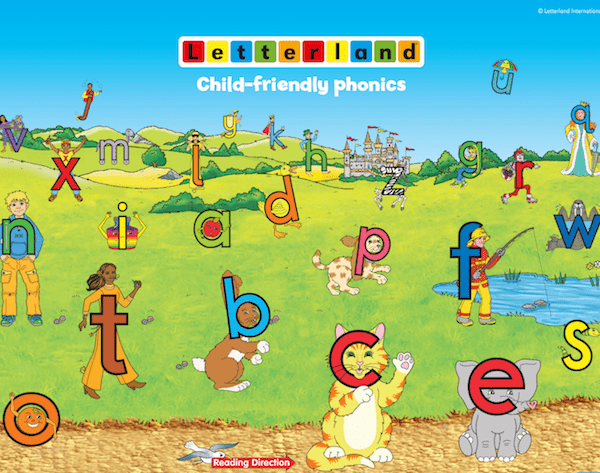
Last year, Keys to Literacy decided that it was time to offer a phonics program and literacy professional development for phonemic awareness and phonics instruction in the primary grades. We knew it had to be up to the quality, high standards that educators have come to expect from Keys to Literacy. That is why we chose Letterland!
What are phonemic awareness and phonics?
As noted in the National Reading Panel report (2000), research establishes that phonemic awareness and phonics are essential components of beginning reading instruction. Here’s a quick summary of these components adapted from Put Reading First: The Research Building Blocks for Teaching Children to Read from the National Institute for Literacy.
- Phonemic awareness is the ability to notice, think about, and work with the sounds in spoken words. Before children learn to read print, they need to become aware of how the sounds in words work. They must understand that words are made up of speech sounds, or phonemes. Children can show us that they have phonemic awareness in several ways, including:
- Recognizing which words in a set of words begin with the same sound (bell, bike, boy all have the sound /b/ at the beginning)
- Isolating and saying the first or last sound in a word (the beginning sound in dog is /d/; the ending sound of sit is /t/)
- Combining or blending the separate sounds in a word (/m/, /a/, /p/ into map)
- Breaking or segmenting a word into its separate sounds (up into /u/, /p/)
- Phonics instruction teaches children the relationships between the letters (graphemes) of written language and the individual sounds (phonemes) of spoken language. It teaches children to use these relationships to read and write words. The goal of phonics instruction is to help children learn and use the alphabetic principle – the understanding that there are systematic and predictable relationships between written letters and spoken sounds. Knowing these relationships will help children recognize familiar words accurately and automatically and “decode” new words. The International Literacy Association recently published a free guide titled Explaining Phonics Instruction that provides a short overview of phonics instruction.
What is Letterland?
Letterland is a complete phonemic awareness, phonics, spelling and handwriting program for PreK through Grade 2. Young children learn letter sounds and phonics concepts through story-based characters that are visually embedded in letters. Letterland uses a structured, systematic phonics sequence and incorporates a multi-sensory approach to activate learning through visuals, music, movement, art, and role-play. It is the most engaging and fun program I have ever seen for teaching foundational reading and spelling skills!
The character names and stories help young children associate a sound (phoneme) with a letter (grapheme) through alliteration (the first sound in each character’s name is the phoneme), an action trick, and a picture of the character that is embedded in the letter in a way that helps associate it to the letter’s formation. Here are a few examples of Letterlanders:
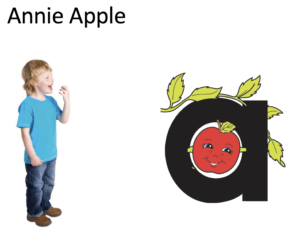
Meet Annie Apple. She says /a/. Her action trick is to bring your hand to your mouth as if you were taking a bite of an apple. Annie Apple lives in an apple orchard and has many animal friends and visits from astronauts and acrobats.
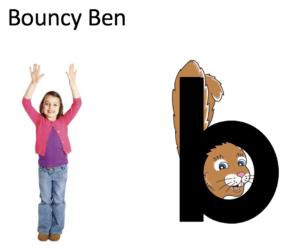
Meet Bouncy Ben. He says /b/. His action trick is to put your arms above your head just like his ears go up. Bouncy Ben lives in a burrow by the riverbank by the big bridge. He is the best bouncer and has 6 brothers.
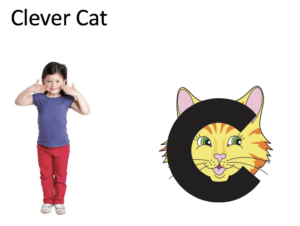
Meet Clever Cat. She says /c/. Her action trick is to stroke her cheeks as if you were stroking whiskers. Clever Cat lives in a cottage by a castle. She likes to cook, count, clean, carry things, and use the computer.
From Simple to Advanced Phonics Concepts
In pre-k and kindergarten, the instructional focus is on learning the basic consonant and vowel sounds associated with the letters, along with letter names. As students move through grades 1 and 2, they learn more complex phonics concepts, such as digraphs (two or more letters used to make a single sound) and vowel-r (where the r modifies the sound of the vowel before it). The Letterlander stories combine to make sense of these more complex patterns. Here are two examples:
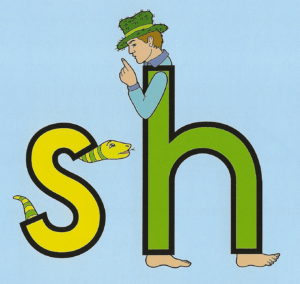
Digraph /sh/: Whenever Sammy Snake starts to hiss loudly behind Harry Hat Man’s back, Harry turns around and says sh to hush Sammy up because he hates noise. Words that start with the /sh/ sound: ship, shell, sheep, shark.
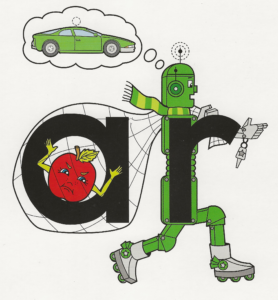
Vowel r sound /ar/: Watch out when there’s a robot around. They cause trouble in words because they steal letters. When there is a vowel behind a robot’s back, don’t expect that vowel to be making its usual sound. It will be too startled to speak! When you see an apple behind a robot’s back you have already spotted Arthur Ar, the apple stealer! He reports back to his ringleader, Red Robot, with his last name Ar! Words with the /ar/sound: car, farm, park, star.
Learn More
Keys to Literacy is the exclusive provider of Letterland program materials and related professional development for New England. We also provide generic phonemic awareness and phonics training to schools across the country. To learn more, visit the phonics page on our website.

 Joan Sedita is the founder of Keys to Literacy and author of the Keys to Literacy professional development programs. She is an experienced educator, nationally recognized speaker and teacher trainer. She has worked for over 35 years in the literacy education field and has presented to thousands of teachers and related professionals at schools, colleges, clinics, and professional conferences.
Joan Sedita is the founder of Keys to Literacy and author of the Keys to Literacy professional development programs. She is an experienced educator, nationally recognized speaker and teacher trainer. She has worked for over 35 years in the literacy education field and has presented to thousands of teachers and related professionals at schools, colleges, clinics, and professional conferences.
Joan,
Does Letterland progress to advanced phonemic awareness skills like deletion, addition and substitution?
Thank you!
Emily
Yes, it does include a variety of phonemic awareness activities that are used along with practice decoding words with letters.
great work its my favourite teaching as a second language
How does your program work in a virtual teaching and learning environment?
The University of FL has a helpful collection of resources for teaching foundational skills online: https://education.ufl.edu/ufli/virtual-teaching/main/ The Letterland program is making a host of resources available for teaching their program online/remotely: https://us.letterland.com/covid-19
Different phonics-based games and activities are a good way of teaching reading to kids. I believe games and fun activities make things more appealing, interesting, and attractive for kids, That is why seeking their attention by this is easy. There are also some learning at home phonics-based reading programs like https://readwk.com/children-learning-reading-program/ and others that could help parents in teaching their child how to read that at home. This could be helpful for parents with toddlers, preschoolers, or kindergartners and especially those who are looking to teach at home, Thanks